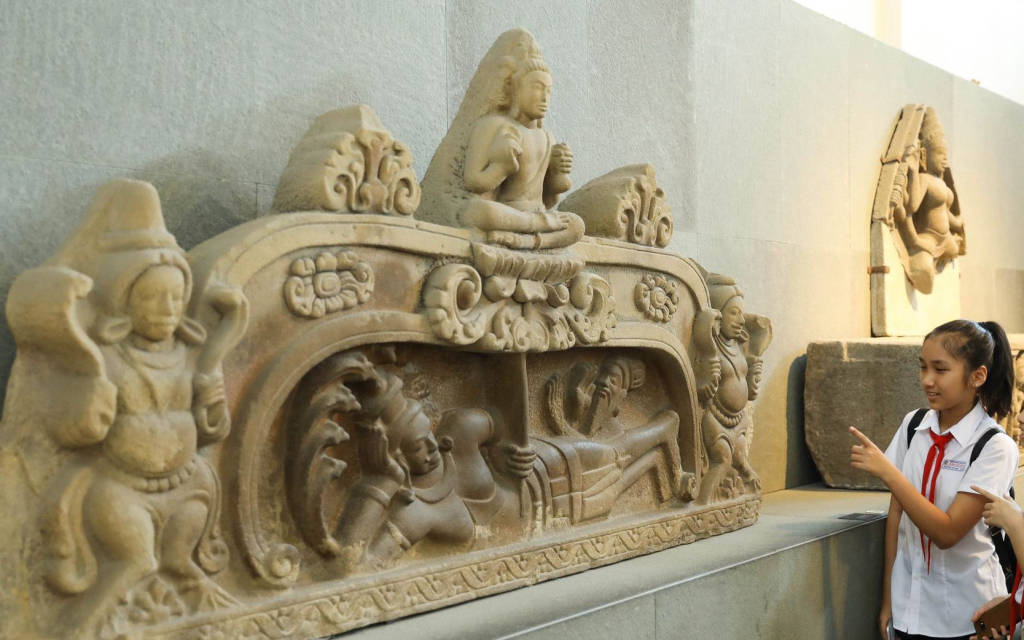The Cham Sculpture Museum in Da Nang is one of the most attractive destinations for visitors exploring this beautiful coastal city. With its convenient location in the city center, the museum is not only a place to preserve the valuable cultural heritage of the Champa civilization but also an ideal spot for those who love history, sculpture art, and wish to experience the distinctive beauty of ancient cultures. Here, visitors can freely wander through a peaceful space, admire beautiful artworks, and delve into captivating historical stories.
History of the Cham Sculpture Museum
The Cham Sculpture Museum was established in 1915 under the French colonial administration, with the purpose of preserving and showcasing unique sculptures of the Champa culture. The Champa civilization, an integral part of Vietnam's history, flourished from the 4th to the 13th centuries. The sculptures in the museum come from Champa heritage sites spanning from Quang Binh to Binh Thuan. When visiting the museum, tourists can admire exquisite artworks, including statues of Buddha, Hindu deities, and other pieces representing the grandeur of an ancient civilization that existed for thousands of years.
Museum Space and Sculptural Works
The Cham Sculpture Museum is not only a place to preserve historical artifacts but also an impressive artistic space. Visitors can admire over 300 sculptures, including statues of gods, Buddha, bas-reliefs, and other items. Each piece tells a unique story, reflecting the creative brilliance and deep spiritual values of the ancient Champa people. The sculptures in the museum are divided into various themes, ranging from depictions of Hindu gods like Shiva and Vishnu to Buddha statues, each conveying profound insights into the life and beliefs of the Champa civilization.
A Free-Exploration Experience and Discovering Champa Culture
The Cham Sculpture Museum is not just a historical site but also an ideal place for those who enjoy free exploration during their travels. With its spacious and open environment, visitors can move freely, observing the artifacts from various angles. Enjoying the serene atmosphere and learning about the history behind each artwork is a fascinating experience. Especially, the museum caters not only to history enthusiasts but also to those passionate about sculpture and traditional arts.
Connecting Culture and Tourism in Da Nang
As one of the significant cultural attractions in Da Nang, the Cham Sculpture Museum plays a crucial role in preserving heritage and linking tourism with culture. When visiting Da Nang, you cannot miss the opportunity to explore this museum and gain deeper insights into the history of an ancient civilization that greatly influenced other cultures in Southeast Asia. Here, you will have the chance to connect with fascinating historical narratives and experience the beauty of remarkable artworks that have been preserved for centuries.
Impressions and Tips for Visitors
When visiting the museum, tourists should spend at least a morning or afternoon exploring and learning about the artifacts. If you are a history and art lover, you will not want to miss the chance to admire the unique sculptures on display. Be sure to bring a camera to capture the memorable moments of your trip. You can also combine a visit to the museum with other famous attractions in Da Nang, such as the Dragon Bridge, Son Tra Peninsula, or My Khe Beach, for a complete and enjoyable trip.
Conclusion
The Cham Sculpture Museum in Da Nang is an unmissable destination for anyone interested in exploring the history and culture of Da Nang. Here, visitors can freely wander through a historical space, admire sculptures, and discover the fascinating Champa civilization. It is a meaningful travel experience, offering not only historical knowledge but also an opportunity to appreciate the craftsmanship of ancient sculptures.
 Register
RegisterSign in Travel Agent
Sign in Supplier
Sign in Affiliate
Sign in Guru



 Bảo tàng Điêu khắc Chăm Đà Nẵng, Đường 2 Tháng 9, Bình Hiên, Hải Châu District, Da Nang
Bảo tàng Điêu khắc Chăm Đà Nẵng, Đường 2 Tháng 9, Bình Hiên, Hải Châu District, Da Nang